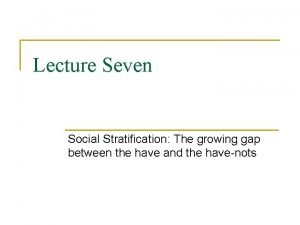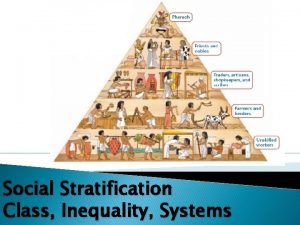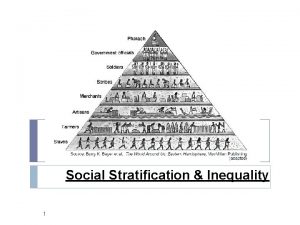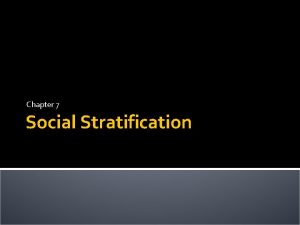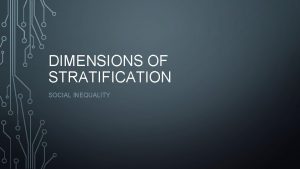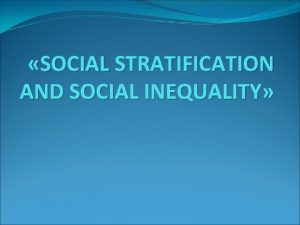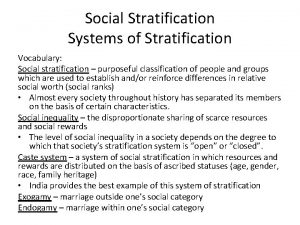SOCIOECONOMIC INEQUALITY Social Stratification Social Stratification is a









- Slides: 9

SOCIO-ECONOMIC INEQUALITY

Social Stratification • Social Stratification is a system of social inequality by which a society ranks categories of people in a hierarchy. • Characteristics of social stratification I. Social stratification is universal. II. Social stratification is social. III. Social stratification is ancient. IV. Social stratification is in diverse forms. V. Social stratification is consequential. (consequences, i. e. life chances &life style )

Social Stratification & Caste and Class System • The Caste System: A caste system is social stratification based on ascription, or birth. • A pure caste system is closed because birth alone determines a person’s entire future, allowing little or no social mobility based on individual effort. • The Class System: A class system is a social stratification based on both birth as well as individual achievement. • Class systems are more open than caste systems, so people who gain schooling and skills may experience social mobility.

Social Stratification & Social Mobility • Social mobility refers to the movement within the social structure, from one social position to another. • It means a change in social status. • It is said that the greater the amount of social mobility, the more open the class structure. • The concept of social mobility has fundamental importance in ascertaining the relative “openness” of a social structure.

Types of Social Mobility • Social Mobility is of two types. (i) Vertical Mobility (ii) Horizontal mobility • Vertical Social Mobility: It refers to the movement of people from one stratum to another or from one status to another. • It brings changes in class, occupation and power. It involves movement from lower to higher or higher to lower.

• Types of Vertical Social System: There are two types of vertical mobility. One is upward and other is downward mobility. • When an individual moves from lower status to higher status, it is called upward mobility. • Downward mobility takes place when a person moves down from one position to another and change his status.

• Horizontal Mobility: It refers to the movement of people from one social group to another situated on the same level. • It means that the ranks of these two groups are not different. • It indicates change in position without the change in status.

• Apart from the above two broad types of social stratification, there are two other types of social stratification in terms of dimension of time. They are: (i) Inter-generational mobility: When changes in status occur from one generation to another, it is called intergenerational mobility. • For example, if the son changes his status either by taking upon occupation of higher or lower rank with that of his father, there intergenerational mobility takes place.

(ii) Intra-generational mobility: When changes in status occur within one generation, it is called intra-generational mobility. • For example, the rise and fall in the occupational structure of a family which leads to change in its social status within one generation is called intra-generational mobility.
 Social stratification vs social inequality
Social stratification vs social inequality Social classes in social stratification
Social classes in social stratification 1-6 solving compound and absolute value inequalities
1-6 solving compound and absolute value inequalities Socioeconomic model
Socioeconomic model Socioeconomic examples
Socioeconomic examples Symbol of socioeconomic status
Symbol of socioeconomic status A personality measure of a person's convictions is
A personality measure of a person's convictions is Mixed social stratification
Mixed social stratification Stratification of gender
Stratification of gender Social stratification slideshare
Social stratification slideshare
